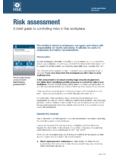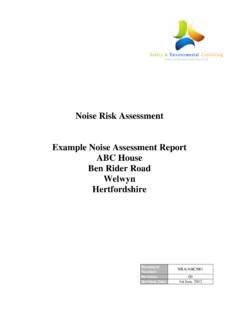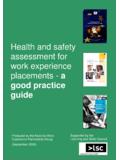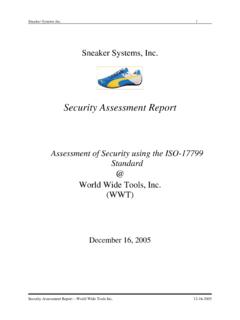Transcription of Risk Assessment Work Sheet - Health and Safety …
1 Heat Stress Check List This check list is only to be used when conducting a heat stress risk Assessment it should not be used for the purposes of a thermal comfort risk Assessment . Risk Assessment work Sheet Please complete one risk Assessment worksheet for each employee. Read the questions carefully, and provide an answer in the relevant space provided. If you require further information, refer to the relevant web pages. Name of risk assessor: Date of Assessment : Job being assessed Location of Assessment Name of employee being assessed Personal status of employee Employees age Is the employee male or female Male / Female Is the employee acclimatised: Yes / No If Yes provide details of acclimation: Is the employee experienced in the job?
2 Yes / No Is the employee experienced in working in the heat? Yes / No Has the employee been trained to work in the heat? Yes / No Please provide a brief description of the work being performed: How many employees are involved in this task? Where was the Assessment conducted? (Please provide a description of the workplace. If necessary use the back of the page to provide a diagram of the workplace and the area). How long (in minutes) does the work typically take? a) Without a break: b) In a typical shift (excluding breaks): Daily / Infrequently How often will this task take place: Is refresher training given to employees? Yes / No If YES how often? What were the external climatic conditions? (If Air measurements are not available, provide a brief temperature: description).
3 Radiant temperature: Air velocity: Relative humidity: Description: Hazard Identification Name of risk assessor: Date of Assessment : Job being assessed Location of Assessment Name of employee being assessed This observational check list helps identify potential heat stress hazards. If you observe any of the hazards described, tick the box to the right of that description. If you identify a heat stress hazards not listed, describe the hazard in the Other box, and tick the appropriate answer. Consideration Description Tick Air Temperature Does the air feel warm or hot? Radiant Temperature Is there a radiant heat source present eg the sun, furnaces; ovens; kiln walls, kilns; dryers; hot surfaces & machinery, exothermic chemical reactions, molten metals, etc.
4 Humidity Is there any equipment that produces steam? Is the workplace affected by external weather conditions? Are the employees wearing PPE that is vapour impermeable? Do your employees complain that the air is humid? Air Movement Is warm or hot air blowing onto your employees Metabolic rate Is the work -rate moderate to intensive? PPE Is PPE being worn to protect against harmful chemicals, asbestos, flames, extreme heat etc? Is respiratory protection being worn? What your employees think Do your employees think that heat stress is a problem? Do your employees complain of feeling warm or hot? Other If you have ticked any of the descriptions to any of the above questions there may be a heat stress risk and you should now conduct a more detailed risk Assessment using the heat stress observation checklist.
5 Personal Risk Factor Checklist Name of risk assessor: Date of Assessment : Job being assessed Location of Assessment Name of employee being assessed This is not intended to replace a medical examination and is only to be used as a preliminary observation tool. If in doubt, seek advice from an occupational Health physician who has a knowledge of working in the heat. Has the employee had a pre-exposure medical examination by a qualified occupational Yes / No Health professional? If YES: Have they been cleared to work in an environment where they may be at risk Yes / No from heat stress If No Consult a physician When was their last medical screening done? When is their next medical screening due? Before this Assessment had the employee completed a pre-exposure medical Yes / No questionnaire?
6 If YES: Were any YES answers provided in the pre-exposure medical questionnaire? Yes / No (If YES consult a physician?). When was the questionnaire last administered? Please provide any other information that may be relevant to this part of the Assessment . Heat Stress Observation Checklists Each of the following check lists addresses one of the one of the six basic parameters. Each parameter is described and a risk score is given for each. The higher the score, the higher the risk it may contribute to heat stress. You should observe the environment, taking note of the description provided, and tick the box that best fits your workplace. This will provide you with an estimated risk score for that parameter.
7 You may tick more than one box if the environment is changing, or if the employee is moving between environments. If you do not see a description that best fits the work situation you are assessing, or are unsure then tick the Don't know box at the bottom of that table. This introduces an uncertainty into the Assessment and requires that you conduct a more detailed qualitative Assessment . Air Temperature What is air temperature and what should you look out for? Air temperature is described as the temperature of the air surrounding an employee. Consider the air temperature surrounding the employee and how you would describe it. Subjective description of air temperature Score Tick Cool -1. Neutral 0. Slightly warm 1.
8 Warm 2. Hot 3. Very hot 4. Don't Know Radiant Temperature What causes radiant temperature and what should you look out for? Thermal radiation is the heat that radiates from a heat source and will be present if there are heat sources in an environment. Examples include: the sun, electric fires; furnaces; ovens; kiln walls; cookers; dryers; hot surfaces & machinery, exothermic chemical reactions, deep mine tunnel walls; molten metals, etc. Observe the surroundings and identify heat sources. Consider how close your employees are to these heat sources. Do they need to wear protective clothing to prevent burns etc? Subjective description of radiant temperature Score Tick Objects colder than the surrounding air are near to worker.
9 -1. There are no heat sources in the environment 0. A heat source is present but the employees are not in close proximity to it. The heat source surface is warm to touch and there is no risk of contact 1. burns. The heat source surface is hot to touch. 2. Employees feel hot when they stand near the heat source. The heat source surface is very hot to the touch and may burn the skin. Employees cannot work in close proximity to the heat source for more than 3. 10 minutes without wearing PPE. Contact with the heat source will cause burning. Employees cannot work in close proximity to the heat source for more than 5. 5 minutes without wearing PPE. Workers are not permitted to work in the environment without PPE to 6.
10 Protect them from the radiant heat in that environment. Don't Know Air Velocity Air velocity explained Air velocity is the speed of air moving across an employee and may affect the employee if it is not cooler than the environment. To help you, four categories of air velocity are provided. They are Still, Low, Moderate and High 1. Still air, is where there is no noticeable flow of air;. 2. Low air speed, is when you can just feel air movement on exposed flesh;. 3. Moderate air speed, is when you can feel air movement ( a light breeze) on exposed flesh;. 4. High air speed, may be similar to the air speed on a windy day, or at or near fans or other machines or equipment that generate air movement. Things to look out for are wind sources; the presence of fans to reduce the temperature ( during specialist maintenance work ?)

















